
Was King Arthur's Guinevere a Real Historical Queen?
There is perhaps no more famous character in British legend than that of King Arthur. For centuries, people have been reading tales of King Arthur and his knight’s exploits. Of all the characters that appear in these legends, Arthur’s wife, Guinevere, supposed queen of England, is perhaps the least well-fleshed out. She is sometimes portrayed as a loyal, loving wife tempted away from her husband, and other times portrayed as treacherous and untrustworthy. Guinevere’s character changes from writer to writer, which leaves us with one question, who was Guinevere, really?
Who was Guinevere in the Arthurian Tales?
Guinevere’s depiction can vary greatly from tale to tale, but some things stay fairly static. She is always depicted as King Arthur’s wife, who has a bad habit of being kidnapped by his various enemies. Today, she is seen as an early example of the ‘damsel in distress’ trope that has been so common for centuries.
She is also commonly depicted as being disloyal to Arthur in some way. Later works tried to flesh her out, adding the story of her affair with King Arthur’s most beloved knight, Lancelot. This affair ultimately leads to Arthur's (and Camelot’s) fall in most of the later versions of the legend.
- Sir Lancelot: Exploring the History Behind the Legend
- Court of King Arthur’s Round Table Discovered, Claims BBC Presenter
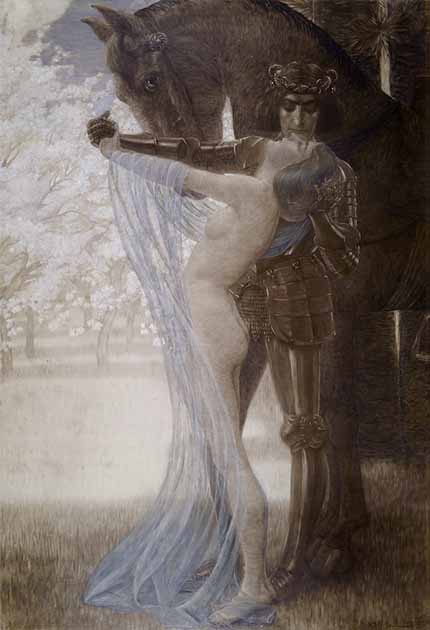
Knight and Lady, probably Sir Lancelot and Guinevere. 1902 painting by Wilhelm List (Public Domain)
The Origin of Guinevere
The earliest mention of Guinevere is in Geoffrey Monmouth’s History of the Kings of Britain. This book laid out the basics of the traditional Arthurian legend that later authors would use as a source for elaboration. It includes many of the legend’s central characters, but in more basic and less detailed forms.
This text refers to Guinevere as Gwenhuvara, which comes from the Welsh name Gwenhwyfar. The meaning of the name is not known, but we do know it references a female figure from Welsh mythology famed for her bad reputation. The name was associated with the idea of infidelity, and as such, was still used as a way to insult a young woman’s character up until the end of the 19th century.
In Monmouth’s version, Guinevere is simply described as Arthur’s queen and a great beauty descended from the Romans. According to the tale, Arthur leaves Camelot to wage war in Europe and leaves his wife and kingdom in the care of his traitorous nephew, Mordred. Mordred wastes no time in seducing Guinevere and taking the throne for himself.
When Arthur returns, Guinevere flees the kingdom due to feelings of guilt and joins a nunnery. Mordred and Arthur go on to duel it out in a great battle that ends with them both mortally wounded.
Monmouth never goes into detail about the affair between Mordred and Guinevere. Authors who came slightly later, like Wace (1110-1174 AD) and Layamon (12th-13th century), were less generous in their depictions of Guinevere.
These authors showed her as complicit in the coup. Most contemporary writers disagreed with this take, however, and usually depicted her as having been abducted by Mordred and being forcefully seduced.
From these early versions of the tale, it is hard to learn much about Guinevere. She is never given much characterization; she primarily acts as a plot device. All we can really discern is that her character may be at least partly based on a figure from Welsh mythology.
- Morgan le Fay: How Arthurian Legend Turned a Powerful Woman from Healer to Villain
- The Arthurian Tale of Elaine of Astolat, Lady of Shalott
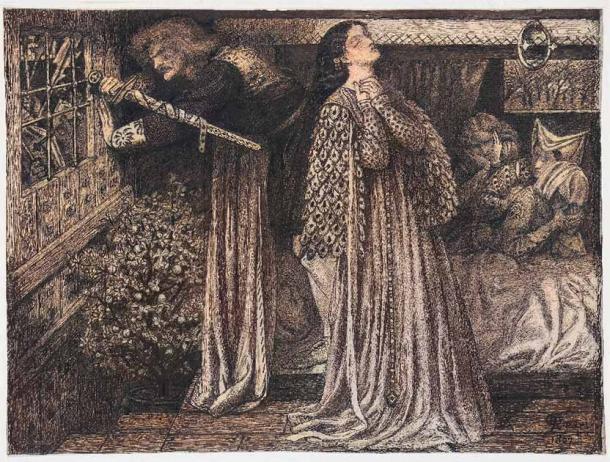
“How Sir Launcelot was espied in the Queen's Chamber, and how Sir Agravaine and Sir Mordred came with twelve knights to slay him”, inscribed in gold on the original frame. Dante Gabriel Rossetti, 1857 (Public Domain)
Guinevere Fleshed Out by Chretien de Toyes and Marie de France
De Toyes and De France were the first writers to focus on the character of Guinevere. The two of them were poets active in the late 11th to early 12th century. They were both associated with Eleanor of Aquitaine and her daughter Marie de Champagne.
These women were largely responsible for the rise in popularity of the courtly love genre during this era. This was a poetic medium that focused on strong women with defined characters.
It is believed many of these strong female characters were at least partly inspired by Eleanor and Marie. We know for certain that Chretien was given his story of Guinevere by Marie and was told to put it into poetry.
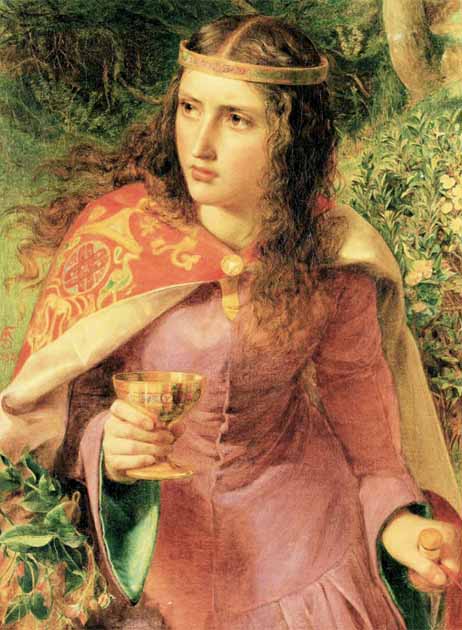
Queen Eleanor by Frederick Sandys, 1858. Eleanor of Acquitane may have been an inspiration for the evolution of Guinevere’s character (Public Domain)
Between the two versions of Guinevere, Chretien’s and France’s, we can’t be sure whose came first. This is because none of France’s works can be accurately dated. Most scholars tend to agree that France’s work probably came slightly later, as she tends to invert the central trope of courtly love tales (that women need rescuing by men). This inversion would only work if her readers were already used to the trope by reading the works of poets like Chretien in the first place.
In France’s Lanval, the main character, Lanval, is one of Arthur’s knights. He leaves the king’s court after being humiliated during an argument and enters the fairy world. There he falls in love with a fairy princess and spends some time among the fairies. Eventually, he decides to return to court, but he is told by the princess to keep their love a secret. If he does this, she will rescue him when needs her the most.
Upon returning to court, he is promptly propositioned by the sultry Guinevere, who has a well-deserved reputation for sleeping with the king’s knights. Lanval rebuts her advances, which enrages her. He calmly explains that he cannot sleep with her because he is already in love with the fairy princess. Sadly, in doing so he breaks his vow.
This only enrages Guinevere further, and she runs to King Arthur, accusing Lanval of attempting to seduce her. He is arrested and put on trial. At his trial, he calls for his fairy princess but expects no rescue. Ultimately, the princess does come, rescuing him in the nick of time.
Chretien’s work follows the more traditional narrative of Guinevere being kidnapped and needing rescuing. She is kidnapped by Lord Maleagent, and King Arthur’s knights are dispatched to rescue her. The tale revolves around Lancelot as he tries to rescue Guinevere. While he does so, Guinevere plays various mind games with the noble knight, designed to question his honor, noble nature, and loyalty.
In both writers' works, Guinevere is disloyal to her husband. The contrast is that in France’s work, she doesn’t love Arthur and is bored. However, in Chretien’s tale, she loves her husband but loves Lancelot more. Despite this difference, her actual characterization, especially her confidence and arrogance, is similar in both works, and it is likely she is partly based on the writers’ patrons, Eleanor of Aquitaine and her daughter Marie de Champagne.
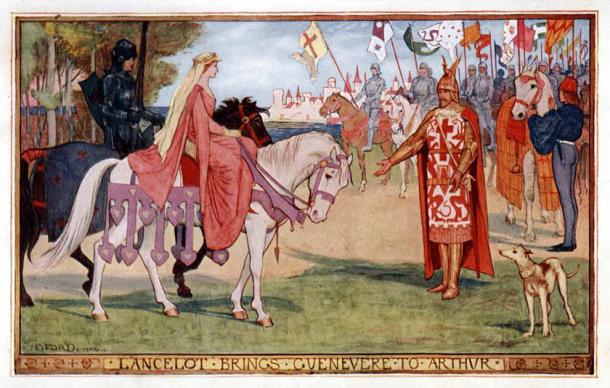
"Lancelot Brings Guinevere to Arthur", an illustration from "The Book of Romance" (Amy G / CC BY 2.0)
Was Guinevere Modeled on a Celtic Goddess?
Rather than Guinevere having been a real historical figure, some modern scholars believe Guinevere was based on early Celtic or Welsh goddesses. Roger Sherman Loomis, an American scholar and a renowned expert on Medieval and Arthurian literature, believed Guinevere was a “Celtic Persephone”.
By this, Loomis meant that she was like the Greek fertility goddess in Greek mythology, who was abducted by Hades and dragged down to the underworld. Like Persephone, Guinevere metaphorically dies by being abducted and is ‘reborn’ by being rescued. He argued that, like ancient fertility goddesses, she could not be held accountable for her infidelity like a mortal.
Instead, Loomis felt that Guinevere is not meant to be judged but admired. He believed Guinevere represented a goddess staying true to the natural self rather than conforming to the cultural expectancy of the time that women should obey the desires of men. In his reading of her character, Loomis takes a normally maligned character and almost turns her into an early feminist icon.
Another scholar, Caitlin Matthews, takes a slightly different approach. Matthews believes Guinevere is Britain’s answer to the goddess of Ireland, Eriu. If we go back to the original Welsh tradition, Arthur was depicted as having been married to three Guineveres. According to Matthews, these different Guineveres are copies of the three Celtic goddesses Eriu, Banba, and Fodla.

The Harp of Erin, a painting depicting the Celtic goddess Eriu, who is, to some, the goddess that is Ireland, and may also have inspired the character of Guinevere. Thomas Buchanan Read, 1867 (Public Domain)
Guinevere, the Goddess Sophia, and the Cathars vs. the Catholic Church
Another school of scholars, largely led by Denis de Rougemont, a Swiss writer and cultural theorist, believed Guinevere was closely tied to the Cathar religious sect. These scholars believe that the kind of courtly love poetry in which Guinevere’s character was first detailed, such as de France’s and de Troye’s works, were allegorical representations of the Cathars, who were thriving in France during the 11th and early 12th century.
The Cathars were a Christian sect who vehemently opposed the Catholic Church and everything they believed it represented. The Cathars felt the church was corrupt, and that it was Satan who had written the Bible. To them, the clergy was self-serving and driven only by a lust for wealth and power, rather than serving the common man.
The Cathars worshiped the goddess of wisdom, Sophia. The above scholars believe that the strong female characters that were central to courtly love poetry were representations of Sophia. When the female character is abducted, her abductor represents the Catholic Church, the enemy of the Cathars and Sophia.
In this interpretation, the noble knight represents the loyal Cathars. This means that Guinevere represents Sophia, Mordred the Catholic Church, and Arthur is the defender of the Church. Lancelot represents the Cathars, protecting Sophia from the Catholic Church.

Statue of Sophia, goddess of wisdom to Cathar Christians. Sofia, Bulgaria. The Cathars viewed Arhurian legends as metaphors for Sophia and the Catholic Church. (Railroadwiki / CC BY SA 3.0)
This theory would also help to explain why Guinevere’s portrayal changed so abruptly after the Catholic Church’s Albigensian Crusade of 1209-1229 AD. This Crusade destroyed the Cathar religion and erased much of its culture in its home region of France.
After the fall of the Cathars, authors increasingly began to Christianize the Arthurian legends. The focus of the tales moved away from chivalric romance and damsels in distress, and instead focused on the hunt for the Holy Grail. While the grail had originally been any old magical artifact, these writers tied it to the story of Christ and the Last Supper.
Perhaps the most famous example of the Christianized Arthurian legend is Thomas Mallory's Le Morte D’Arthur from 1469 AD. In this version, when Arthur and Guinevere first met, he fell madly in love with Guinevere, but she didn't feel the same. He was warned by Merlin that she was destined to fall in love with Lancelot and betray the king. Arthur, however, ignored the wizard's warnings.
Guinevere acted as the dutiful wife until she met Lancelot. They fell madly in love and tried to hide their affair. In Mallory’s version, Arthur was condemned for his arrogance and pride, but Guinevere got off rather lightly.
Arthur ultimately forgave her (after trying to kill her), and she joined a convent so that she could spend her life in service of others. Lancelot’s path ended in a similar way, with him renouncing the life of a knight and setting out to live a humble Christian existence. The two were redeemed through their Christian values and shown as being united spiritually in a way they could never be united physically after the fall of Camelot.
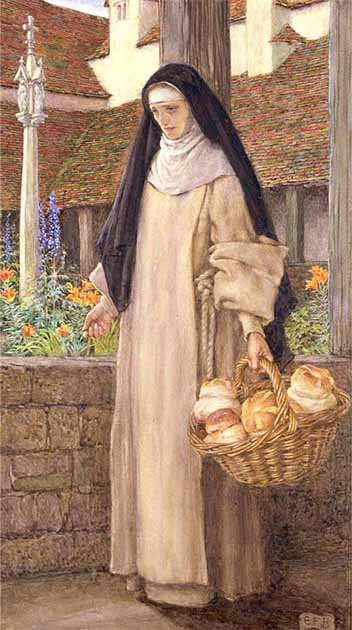
Guinevere was said to join a convent after King Arthur’s death. 'Before the Coming of the Sinful Queen', Eleanor Fortescue-Brickdale, 1910 (Public Domain)
Conclusion
So was Arthur’s Guinevere based on a real queen? There isn’t much, if any, evidence to suggest this. Historians have spent centuries trying to tie King Arthur and Guinevere to real historical figures. It appears to be a situation where, if you look hard enough, you’re bound to find something, however dubious.
Instead, Guinevere is a product of the times, shaped by people’s beliefs and trends. Early examples of her depiction seem to be based on early Irish and Welsh mythology. As time went on, she became an analog for Sophia of the Cathar sect.
Later still, she was molded again to fit the Christianization of the Arthurian legend. This trend has continued well into modern times. In the 1960s, she was portrayed as the traditional dutiful wife in Camelot. In the 1990s, she was a strong, independent woman in First Knight, and in 2004’s King Arthur, she was a warrior princess.
We’ll likely never know the original inspiration for Guinevere, and who, if anyone, she was originally based on. But this is part of her appeal. She is a nebulous character, useful in gauging society’s attitudes toward women during different eras. If her latest showings are anything to go by, these attitudes are hopefully heading in the right direction.
Top image: Queen Guinevere’s origins and character remain a mystery, and legends seem like mere projections. Representative image. Source: Info @ NextMars.com / Adobe Stock
By Robbie Mitchell
References
Mark, J. April 10, 2019. Guinevere. World History Encyclopedia. Available at: https://www.worldhistory.org/Guinevere/
Coghlan, R. 2019. The Illustrated Encyclopedia of Arthurian Legends. Barnes & Noble Books,
Lindahl, C. et. al. 2002. Medieval Folklore: A Guide to Myths, Legends, Tales, Beliefs, and Customs. Oxford University Press.
Loomis, R. S. 1949. Arthurian Tradition and Chretien De Troyes. Columbia University
Tennyson, A. 1989. Idylls of the King. Penguin Classics.
















Comments
Guinevere isn’t forced into a marriage to Arthur, so her infidelity would not be a ‘feminist’ statement. Anyone who actually thinks it’s a male cultural expectation to be loyal then you’re a twisted individual. There’s some men who think a woman should be loyal while he can cheat and likewise there are some women who think a man should be loyal while she can cheat. But those people are narcissists, so everyhing just comes down to revolving around them.
Infidelity to a person you chose freely to marry is an ethical wrong, you can try laughably to portray it as ‘feminist’ but that just means you haven’t any grasp of what feminism is and only have a grasp of what narcissism is.
"Guinevere is a product of the times, shaped by people’s beliefs and trends."
Absolutely correct as the entire story is an astrological story intended to teach astrology. It is interesting that we remember the story even today, good method of teaching, hey!